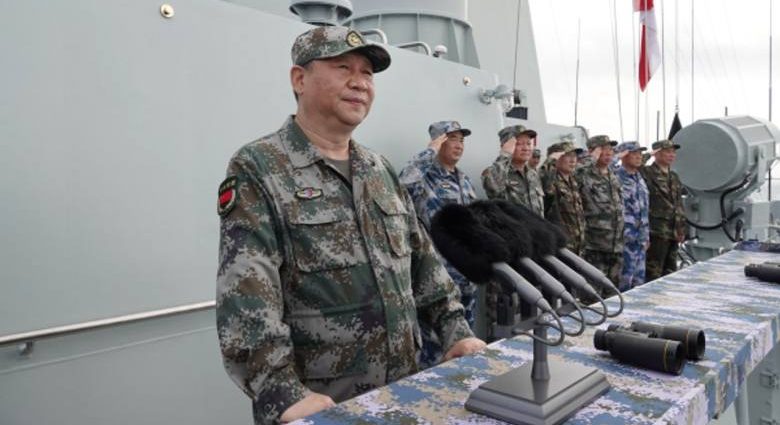For the first time, China has released video footage of its latest Type 094A nuclear-powered ballistic missile sub (SSBN) and Type 093 nuclear attack sub (SSN), a potent show of naval might ahead of China’s 20th Communist Party Congress in October.
Chinese state media featured the subs in a training video for Liaoning, China’s first aircraft carrier, the South China Morning Post reported. The Type 094A was put into service on April 23 last year as part of celebrations that President Xi Jinping presided over to mark the 72nd anniversary of the People’s Liberation Army-Navy (PLA-N).
The Type 094A can launch the JL-3 submarine-launched ballistic missile (SLBM) with a 10,000-kilometer range, sufficient to hit the US mainland. Apart from the Type 094A, two other major surface combatants were launched during the ceremonies, namely the Type 075 amphibious helicopter assault ship and the Type 055 Renhai-class cruiser.
The South China Morning Post report mentions a separate September 28 video that shows several J-15 fighters launched from the Liaoning scrambling to simulate dogfights and maneuvers used in encounters with provocative aircraft. In the video, the Chinese pilots spoke English when encountering their simulated counterparts.
The report also stated that the carrier coordinated with other warships for joint missions involving early-warning air surveillance, air and missile defense, and anti-submarine operations.
In addition to showcasing its latest naval combatants, in late September, a photo of the Liaoning with 24 J-15 carrier-based fighters on its deck surfaced on Chinese social media.
Eurasia Times notes that this is the largest number of J-15 fighters ever seen in public, apparently indicating that China can soon undertake high sortie generation rates (SGR) and is quickly gaining proficiency in carrier operations.
Chinese state media released a video in late September showing a J-15 fighter overflying what appears to be a US Arleigh Burke-class destroyer. The Warzone notes that it is unclear where the video was shot, but the encounter likely occurred in the Taiwan Strait.
China’s prodigious display of naval might may have significant doctrinal as well as political connotations. The muscle-flexing may indicate a growing ability to coordinate surface and subsurface assets and, at the same time, strengthen the political credentials of President Xi for a possible third term.

“Weapon demonstrations always have political significance to help set the tone for big political events like the Party Congress,” said Lu Li-Shih, a former naval instructor at a Taiwanese naval academy, was quoted as saying by the South China Morning Post.
“All the strategic weapons, especially aircraft carriers and submarines, become good marks on a report card for Xi’s achievements over the past decade,” Lu said.
In doctrinal terms, Daniel Kostecka notes that China’s carriers address a need to project force and employ sea-based airpower against enemy-held islands and reefs, attacking enemy elements posing a threat to sea transport and providing air cover for long-distance landing operations.
This doctrine may translate to attacking South China Sea outposts held by other claimant states and Taiwan’s frontline islands, protecting amphibious landing ships for island capture operations against air attack while supplementing land-based aviation.
For China’s subs, Lyle Goldstein and William Murray note that China views its submarines as an asymmetric platform against superior US naval power. Goldstein and Murray say that China’s submarine doctrine is increasingly oriented to anti-submarine warfare (ASW), keeping in line with the adage that the best anti-submarine weapon is another submarine.
The writers also mention that China would likely employ submarines to stalk and sink US carriers inherently suited to penetrating their extensive escorts. Such a mode of operation would see China’s submarines deployed as “lone wolves” to maximize their stealthy characteristics against US warships and submarines.
However, the near-simultaneous deployment of China’s nuclear submarines and aircraft carriers may also signify a push to integrate the two assets into a coherent naval formation, which technology limitations may have previously barred.
In an article for Proceedings, Kevin Peppe argues that SSNs such as China’s Type 093 could be used to support carrier battle groups, departing from previous “lone wolf” deployments.
He states that SSNs could perform covert intelligence gathering, insert special forces in advance of the carrier strike group and perform pre-enabling cruise missile strikes to pave the way for carrier aircraft or amphibious assault forces.
Peppe notes that there should be effective communication between the SSN and carrier battle group commander for such coordination to be possible. He emphasizes that future communications suites aboard SSNs must include a real, viable, and near-zero defect “bell-ringer” system that maintains communication between the SSN and carrier battle group commander at any depth and speed.

However, at the time of his writing in the late 1990s, Peppe states that current technologies, whether radio or acoustic-based were inadequate for the task.
Given that, China may already have developed the technology to allow its SSNs to coordinate with its carrier battle groups, enabling coordination between its surface warships and submarines.
In a September 17 article, the South China Morning Post cited Chinese researchers as saying they had developed and tested underwater communications technology in the South China Sea that allows submarines and drones to maintain contact over more than 30,000 square kilometers.
The study, conducted by a Chinese research team in northwestern China cited in the article, also claimed to have developed a “listening device” that picked sound signals from 105 kilometers away at a depth of 200 meters in a vital submarine passageway.
The study said the data transmission rate reached nearly 200 bits per second, on par with a bandwidth of very low-frequency radio sent by a naval command to nuclear submarines using the world’s largest land-based antennas.
The South China Morning Post report noted that commercial acoustic communication systems are usually limited to a distance of only 10 kilometers, while last year a South Korean team using UK hydrophones achieved a transmission rate of 128 bits per second.

